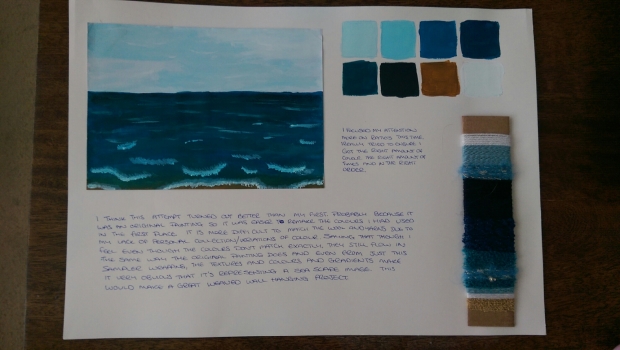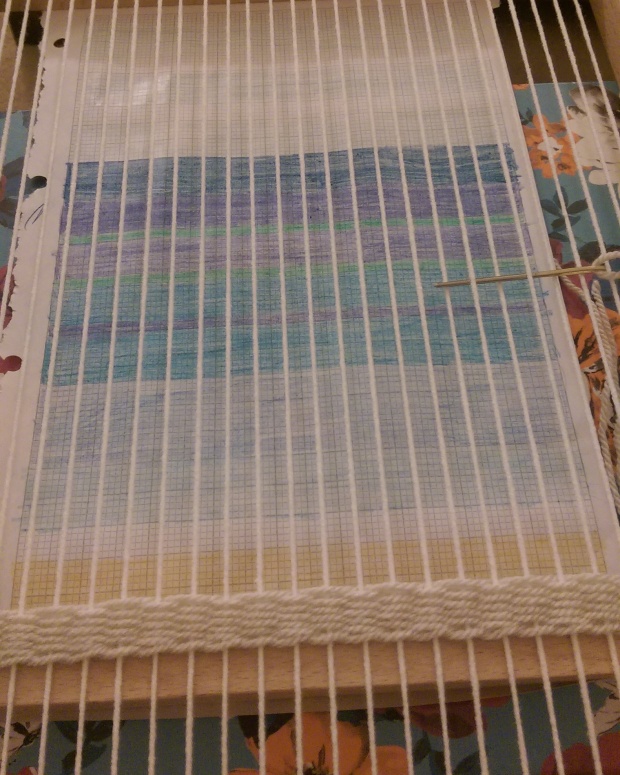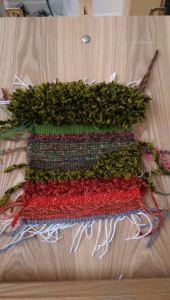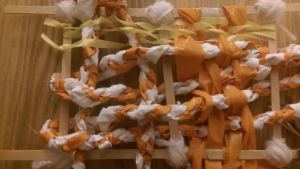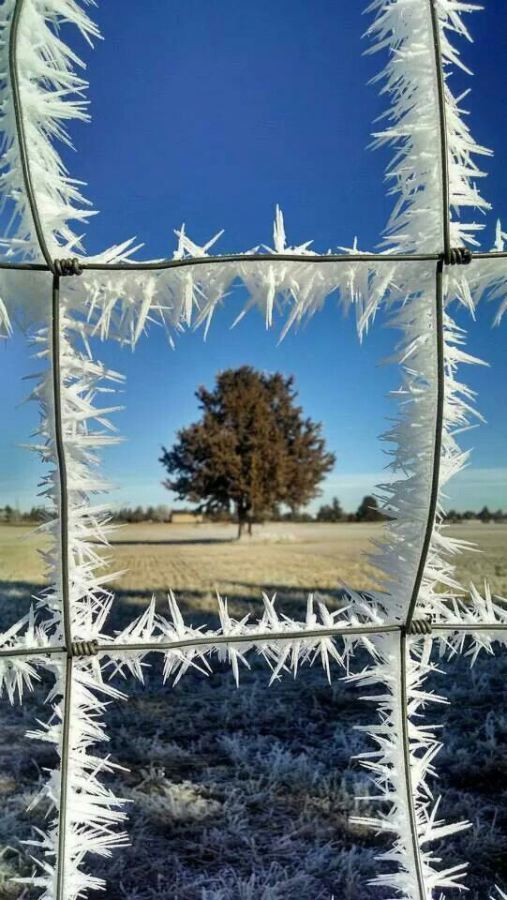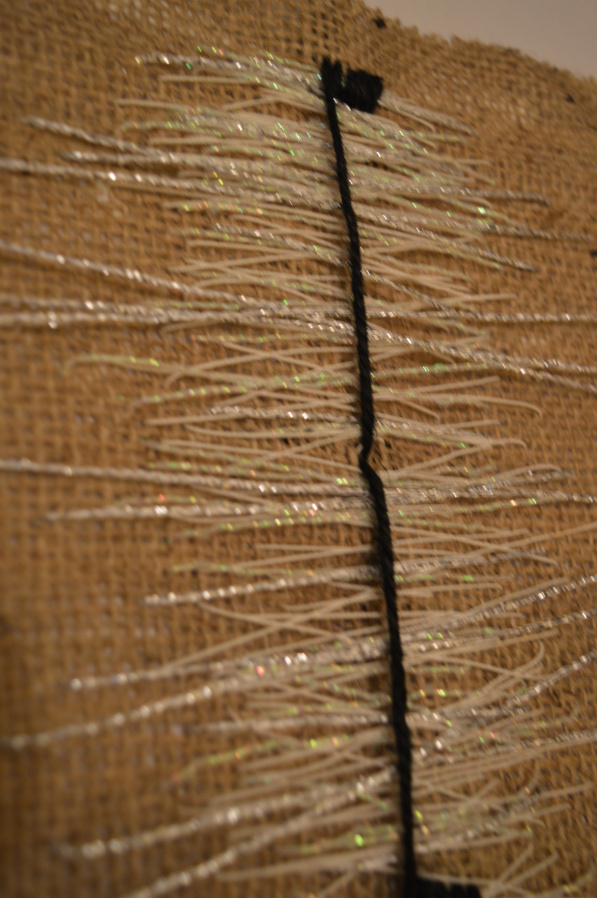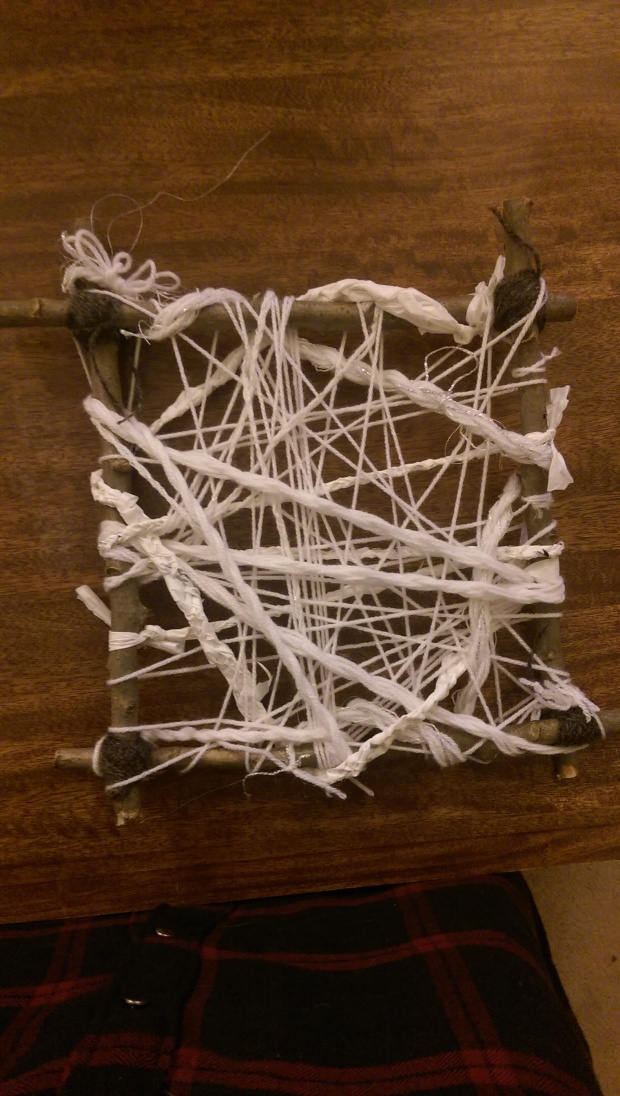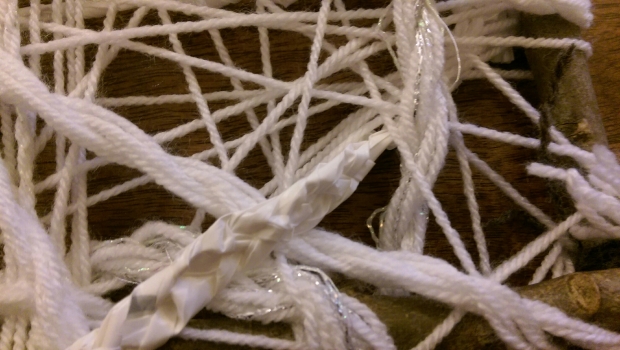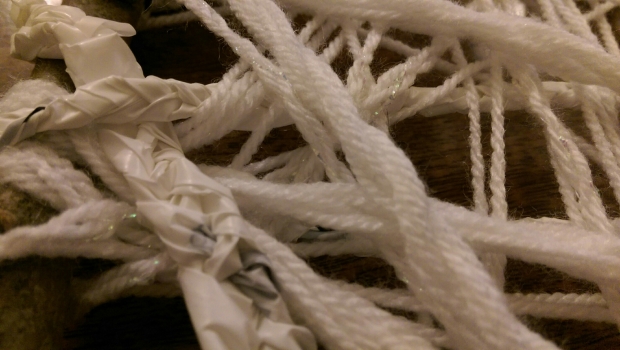I’m having issues copying and pasting my feedback so I’ve given attaching a document a try…
Category: Part 4 – Textile Structures
Assignment 4 – Critical Assessment
Level 4 critical assessment – Looking for laying the foundations – acquisition of skills and good working habits (keeping sketch books and learning logs) – 4 areas of focus: Demonstration of technical and visual skills, quality of outcome, demonstration of creativity and context.
Demonstration of technical and visual skills – I think I have been very competent in this area. I think I have displayed a good understanding of the different techniques we were asked to play with and have produced some visually and texturally effective designs
Quality of outcome – I am very pleased with the quality of my work. I think I have finished most pieces to a good standard. I believe I could research some more professional finishes for future samples, especially if I decide to use it in my final project but given the assignment brief, I feel I have done very well.
Demonstration of creativity – I think I have shown a good level of creativity. From looking at my last assignment work and sketchbooks I feel I have been a bit more adventurous with my sketches and sketchbook work, although I still don’t play with different mediums like collage or anything a lot which I always reflect and feel disappointed about but I tend to do my sketches at work on breaks or when I find a free minute between jobs which doesn’t leave me with a lot of experimental time. But saying this, I am starting to work in my Theme Book now and I have had a few ideas I would like to try out using stitch and collage so I hope that this changes for the next assignment.
Context – I feel that I have really progressed in this area throughout this assignment. I have been inspired to look at other work and try to be critical and objective and really think about what I am seeing when viewing other artists work. I have always been a little scared of research as I have never found it my strong point. I’m quite easily distracted and I always feel overwhelmed when doing a research point as I feel I never know where to start in the vast amount of information that is available on the internet and things and I think that scares me a little. I have also found myself reading more of the suggested and essential reading materials that we were told to look at. I haven’t had enough time to finish books lately but I have started to read and I find myself really enjoying the books that we were told to look at. I hope to finish some of these over the coming months (currently reading: The Textiles Book & Textiles Today)
Feedback – Level 4 – Overall I am very happy with the work I have produced for this assignment. I feel I have shown a great progress of development, especially with the seascape picture I originally did as a sketch then developed with pencil, watercolours, acrylic and finally as my main sample piece for the weaving. I also feel my general sketches and the samples I have produced look great and I feel I have experimented very well with them. This is the first assignment that I feel I have put in my full potential and I have really enjoyed doing this work. I really enjoyed learning to weave too. I do feel like I have found a true passion and calling in this and really look forward to producing some more samples and hopefully using this in my final piece of work.
Woven Structures (Overview)
Did you have enough variety in your collection of yarms and other materials? Which kinds of yarns, etc., did you use most? How do their characteristics affect the look and feel of each sample?
I felt that i did have enoigh variety in my collection to experiment with. I think I used standard 100% acrylic yarn the most as I had more of that than anything else but even with just the one type of yarn, the different techniques we were asked to experiment with gave a great variety of textures to work with. I really enjoyed seeing how the different types of yarns worked with the same technique and had quite dramatic textural differences alloing to create a sence of something new with each dofferent type of yarn.
How did you find weaving in comparison to the other techniques you’ve tried? Did you find it too slow or too limiting?
I found weaving to be the most enjoyable technique of this whole course. I have had a passion for wool ever since I was a little girl and to be able to learn a new way of working with it was, for me, a really incredible and enjoyable experience. I was worried about the time samples were going to take but I found that I flew through them, some of the techniques obviously take longer than others but I think because I was so eager to experiment and my fingers itched to get stuck in, I managed to enjoy the process and worked quite quickly.
How do you feel about your finished sample? Are you happy with the relationship of the textures, proportions, colour and pattern to the finished size? Is there any part that you would want to change? If so, try to identify exactly how and why you wpuld change it.
I am over the moon with my finished sample. I feel the result is almost exactly as I had imagined it. I love the simple and effective textures that I have produced and I feel they all flow together and work in harmony. I don’t think there is alot I would change about this piece, I think the only part I may be a little unhappy with is the sky area as I think I maybe panicked a little when I realised I didn’t have the right amount of yarn that I needed from my planning but I still love how it turned out. I would maybe add some rows of white in the sea areas just to give the sence of waves and if I was to do it again would work more freely and instead of working in straight lines, would have the yarn worked in unleveled areas, gor example instead of just a white strip in the sky for clouds, I’d have areas of white like real clouds with weave around it. But given the brief I am really pleased with the result and the effects I habe produced.
Was there any stage in the whole design process that you felt went wrong? How would you tackle this process differently another time?
Because we were advised at the start of this project to read ahead, when i started the first stage where we had to make colour match wraps, I knew exactly what picture I was going to use and how I wanted to do it so I think the design process was rather straight forward as I had kind of been developing it from the beginning anyway.
Which did you enjoy more – working from the source material or putting colours together intuitively? Why?
Honestly, I enjoyed both equally as much. I really enjoyed every single stage of this project, working from source material was great because, as I’ve never weaved before, it gave me a structure and a starting point to work from, but it was exciting to experiment more freely and let my own ideas flow. I could happily work in either way again.
Stage 4 – Developing design ideas into weaving
I was given 2 options for this stage. I could use to work from a picture I had already made or I could work more intuitively.
I think from the very beginning of this project I had in my head what I was going to do so I decided to follow that and develop my seascape I had been working on from the ‘Analysing colour, texture and proportion’ exercise.
I sat and decided to make a plan of how I wanted the lay out to go. The brief said to work only in stripes so I got an A4 piece of graph paper and worked out my proportion. I had limited coloring pencils available so tired to use as many different shades for the development as possible. The brief did emphasise the importance of being completely prepared and planned for this sample so I tried to keep this in my head as I went on to choose the yarns. I tried to be as fussy about the yarns as possible and really focused on the different textures I had and the possible outcomes they would produce once woven. When I was happy with my choices I made a wrap on card to ensure the colours blended and matched and the textures were correct.
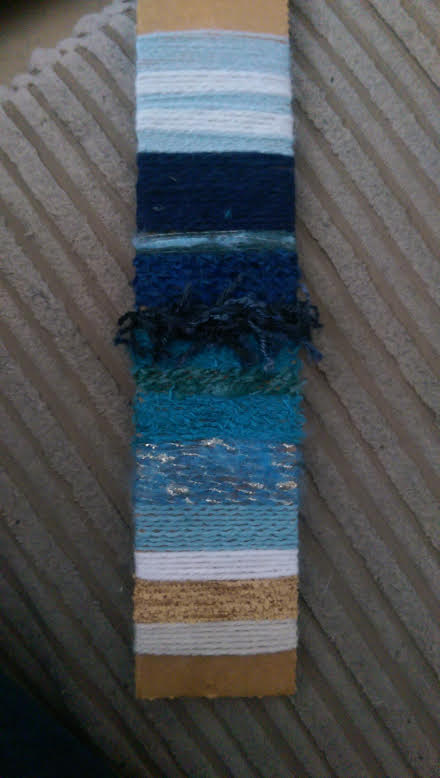
I was very pleased with my choices and loved the way they looked together so I was happy to continue. I had them all laid out in order and made sure I had a noticeable change in colour variation on my graph paper so I knew when to change from one type of yarn to the next.
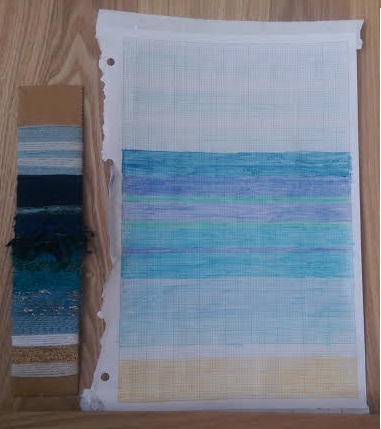
I then got started with the sticking the graph paper to the back of my loom so I could ensure I had my proportions correct and was able to use it almost like a weaving by numbers chart as I went.
I was managing to follow my design decisions just fine until I’d finished the sea area and realised that I didn’t have enough of the same yarn to do all the sky like I had planned in my design process. I had to make an executive decision and decided to use some different colours. After I had completed the sky though I realised I wasn’t happy with it. I had followed my chose yarns for the beginning and had made decisions as I went along as to what stitch I would use to create texture and depth and, with my wrap, had decided to use light colours for the sky with a basic stitch to create the idea of a different entity to the sea, as I had worried that you wouldn’t be able to tell where one stopped and the other began. This worked really well on the wrap and in itself had looked like a decent sample but looking at it on the loom, it wasn’t right. It needed som texture in there it just looked a little bland, so I decided to use some un-spun material I had. This meant that my final design doesn’t look quite as originally planned out and I did worry about that with the brief saying that all decisions should be made before starting but I am really happy with how it turned out in the end.
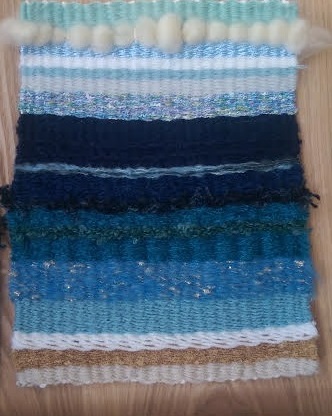
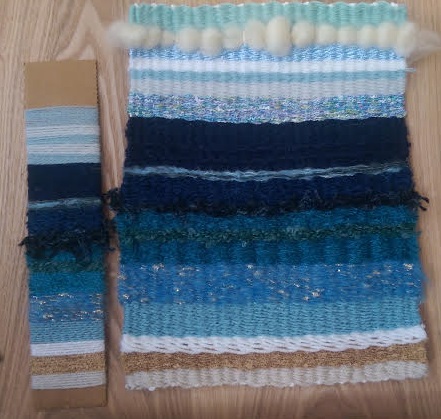
Instead of leaving the ends of the weaving in pairs like the rest I decided to stitch them under to give a cleaner finish.
I’m really happy with how this turned out. I think my choice of yarns and the techniques I chose for texture we correct and it resulted in a piece that was pretty much exactly as I had imagined. I have found a new passion in weaving and I am definitely considering using this for my final project.
STAGE 3 – Experimenting With Different Materials
This was another extremely fun exercise. By this point I had found my feet with weaving and I was really, really enjoying the process. I found it relaxing and extremely enjoyable and even though I had been warned that it was a very long process, I found ideas coming to me very quickly and I was actually getting through samples rather quickly.
This next one asked me to sort my yarns textually and start by doing half a warp of different techniques to see what I enjoyed from what yarn and then to move on to a sample in the second half. Unfortunately, I didn’t have enough yarn available to do 5cm of each plus a sample so instead I just made a sample and tried to judge the effects of each yarn from previous experience.
I was really please with how this had turned out. I had tried to go for a feel of brick, roads and grass and I think I captured this. I really enjoyed playing with the different techniques and seeing the effects of thicker, thinner and multicolored yarns. I tried using more than one colour or texture together too to see how they reacted. Even though I didn’t have chance to play around with the techniques and yarns, I still feel I made correct decisions for what I was wanting to achieve. I would love to learn some different techniques too. I also left the ends un weaved so the difference between the threads and the effects they created were more prominent.
Stage 1 – Preperation & Stage 2 -Basic tapestry weaving techniques
It took me a while to understand how exactly to set up the loom. I bough an A3 (ish) sized loom from Amazon a few weeks ago so tried using the instructions that came with it and the guidance in the brief and eventually managed to get it set up correctly. It’s rather difficult for a first time user but the process, once done a few times, is rather simple to remember and I gained confidence rather quickly doing this.
For my first sample of weaved stitches, I set up my loom how I was asked in the brief, wrapping yarn around the frame to make a total of 40 warped threads. I must admit, I found this a little difficult to handle at first as my loom had notches in the top, I had to go around the whole frame which is probably about and inch deep so there was a lot of space between the top warped threads and the bottom which made my tension a little funny. I did manage to get past this but it did cause a few issues in regards to how to position the loom as on a flat surface it was difficult to pick up the back warp. I did receive a few shuttles and heddle (although I didn’t learn what this was until later) in the pack though so decided to put one through to hold them together which made it a little easier.
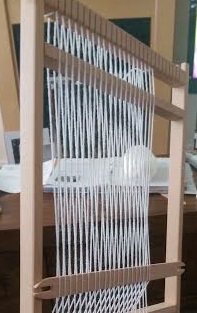
I started with the standard weave technique for a few rows, then alternated the colours row by row. I also tried all the techniques it suggested: Curved wefts, Soumak and Ghiordes Knots. I used grey, pink and white to do this as the colours contrasted well so I could see from up close and from a distance the effects of the difference between techniques.
I was really please with how this had turned out. I do wish that the Ghiordes Knots had been introduced after the standard technique as I felt they covered some of my previous work and if we had been told to do them sooner, I could have incorporated them better. I really enjoyed working with these techniques. I find the soumak a little tricky as you have to be very aware of the tension so as not to mess up the warp but with a bit more practice and using different materials, I found a soon got the hang of it.
I was then asked to play around with different types of yarns.
This was a very fun exercise. I found that my materials I had available were a little limited (I’m currently moving out of my house and had to get rid of a lot of things in the process as our new home has a fraction of the space available than I did have) but I really enjoyed scraping together what I had an having a play around with this.
I think I was a little more free with this one. I knew the techniques and was able to have fun with it instead of concentrating too much. I used a variety of mediums for this:
The first few rows were using a ribbon yarn I found at a charity shop, the next few rows were using some plastic tubing, then I used some scraps of fabric and found some gold elastic to work with. I used the basic weaving technique for this so far as I was interested to see how the different mediums looked in comparison to each other. I then moved on to using plastic bags, having used them before I decided to try the soumak technique which I feel looks very good although found the results a little on the large side for the piece. I then moved on to use some lace that I had stashed away, a little more soumak technique with a 100% acrylic wool then finished with some chunky multi-tonal yarn I found.
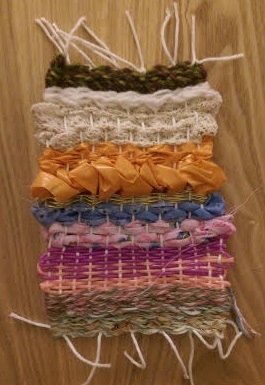
I really love this sample. I love how, even using predominantly the same stitch through out, the different mediums give it a very interesting, textural feel. I’d like to create more samples using different mediums and techniques.
Stage 2 – Experimenting With Structures (Exercise 4)
For this exercise I decided to make a grid structure using coffee stirrers with yarn and double sided sticky tape to hold in place. I started with my collection of blended yarns made using the steps explained at the end of Exercise 3. I had a mixture of wool, plastic bag and cotton thread twisted yarns to work with.
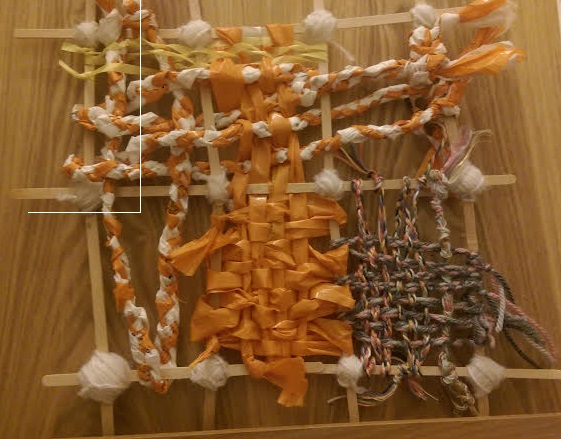
I tried to be as creative as I could but I found this quite difficult for some reason. The carrier bag twists are quite difficult to work with I found. If I were to do this again I think I would have spent a little more time looking at other mediums such as fabrics and cotton threads but unfortunately, I didn’t have enough of these spare in my collection to use for this experiment. I am please with how this came out though. It was fun to experiment with spaces and see how tighter worked spaces contrasted with the spacier ones.
Research Point – The Work Of The Textile Artist
How does the work of the textile artist differ from that of the designer, designer maker or crafts person? Is there any crossover in terms of approach or the way in which each uses ideas or textile processes?
A designer is someone who designs something whether that be a structure, building, piece of clothing, anything, that generally goes on to someone else to be made, build, sewn and so on. It is the first step of any creative process.
A Crafts person is someone who has a skill in or practices a craft like pottery or whittling.
A designer maker is someone who both creates a design and then goes on to develop and create a piece in it’s entirety themselves.
In my opinion, they all cross over completely. Without a design you can’t create. Even if that isn’t a fully developed design, you have to start somewhere and the planning (or even 5 minute thought process) of where to start is all the design process. The only area these 3 different labelled professions may not cross is with the execution on the designers part. If someone designs to give to someone else to create that’s where their process will end, but everyone who creates is a designer, every skill is a craft, every ability is a skill. For me, I think they are truly hand in hand it’s all down to personal preference on what someone would like to call themselves. Therefore I feel these labels can be misleading and confusing.
Choose two internationally known textile artists whose work you find particularly inspiring.
Describe their work, in terms of materials, scale, colour, technique and imagery
Consider how the artist has used any of the elements listed above to express the concepts behind their work
The first artist I wanted to look at was Lucy Brown. She mainly creates larger installations or sculptures for her work made up of woven vintage discarded clothing predominantly undergarments, slips and petticoats in colours of ‘rose’, ‘mint’ and ‘flesh’.
Most of her installations involve suspension, so strands of materials will hang down with sections of weave. She collects her materials from second hand shops and eBay and deconstructs through methods of cutting, ripping, tearing and unpicking, undergoing two processes in the development of her work. First being on a loom in the privacy of her studio then moving to a gallery where the works have been cut loose and are suspended, re-evaluated and the finishing touches applied.
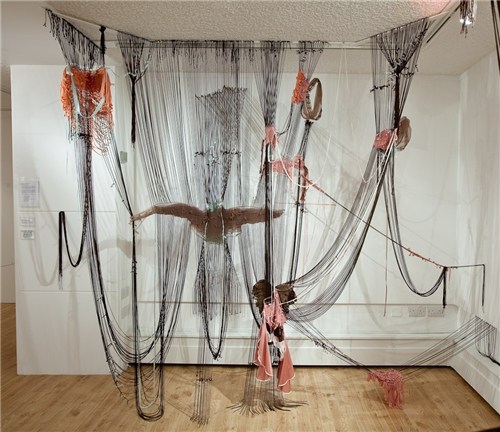
At this point there are themes around the unfinished and unresolved, meaning that works are in a constant state of ‘becoming’. ‘ There is a seductive and obsessive drive with the raw materials, which fuels the desire to make and physically interact with the garments. Weaving is both language and method to reconstruct/ re-invent these raw materials exploring ideas around re-telling/ re-working histories, re-claiming / re-configuring female body image. Weaving by tradition is slow and labour intensive and time becomes part of the process.’
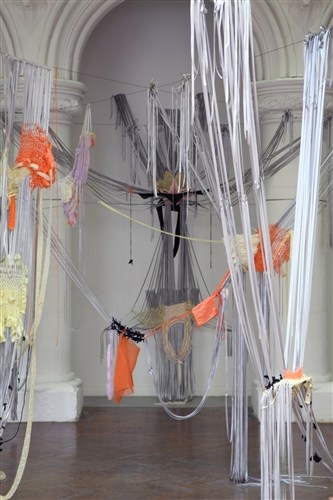
It’s this interaction and ongoing progression, development and manipulation that creates some wonderful finished pieces that I find very seductive and romantic, yet remind me of a time and era gone by. Some of her installation make me feel like I’m looking into an old room, where wall paper is tearing off the walls, curtains are moth eaten and patchy and the life that was once there has now gone. But I the juxtaposition of that feeling in contrast to reality. That the items used are from a different ear and are no longer wanted but have now been used and given purpose to, revived.
Websites used to gain this information are below:
http://www.62group.org.uk/artist/lucy-brown/
http://www.axisweb.org/p/lucybrown/
The next artist I wanted to look at is Heather Belcher. Working with images of coats, sweaters and blankets, she explores hand made felting processes incorporating techniques such as knitting, printing and drawing directly with loose wool fibers to create images onto fabric. My own passion for wool is what attracted me most to this artist. Her work is ‘inspired by the histories and processes associated with hand made felt and particularly with it’s reference to the human figure through early felt body ‘coverings’.’ Her work is usual done to an A3 scope although this is dependent on her medium as she uses paper, fabric and felt.
All her work is very simple in regards to colour using a very natural colour palate of creams, white, grey, blue and green. ‘She is interested in the materiality of felt. Its physical texture is reminiscent of leather or parchment and could perhaps be regarded as a metaphor for skin or paper. Traditionally it has connections to early body coverings which Heather draws upon in her images of clothing to explore of issues of concealment, identity and the duality of absence and presence.’
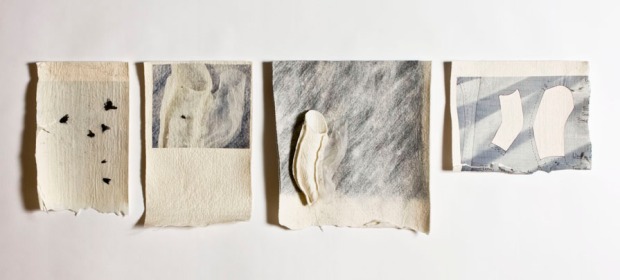
Work by Heather Belcher
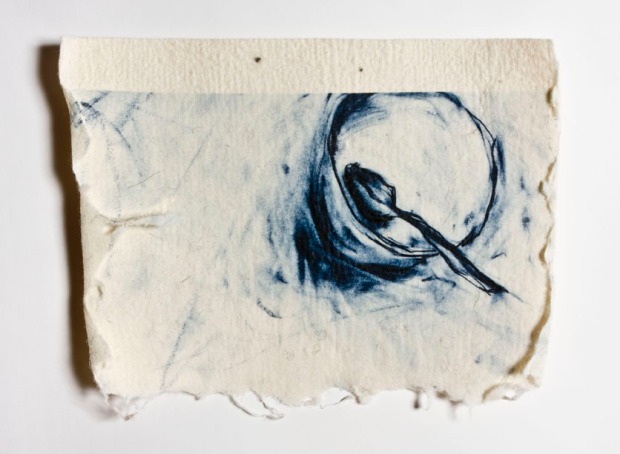
Work by Heather Belcher
I find her work very soft and calming. I love the textural look of her work (having never been able to physically handle a piece) I can imagine her processes and techniques make the work soft and bumpy and very pleasing to hold. Almost telling a story in the feel of the work as well as the aesthetics.
Websites used to gain this information are below:
https://www.westdean.org.uk/study/tutors/heather-belcher
http://www.62group.org.uk/artist/heather-belcher/
Stage 2 – Experimenting with structures (Overview)
Did you enjoy inventing constructed surfaces? Were you surprised at the results? Can you see a connection between your choice of materials and the types of structures you made – regular, irregular, small or large scale? Which samples worked best – and why?
I did enjoy inventing constructed surfaces. I found the results simple, effective and very pleasing. I can see connection between the different materials to the outcome and the amount of variations that are possible is very exciting and creatively intriguing. I think the best ones for me were the Magazine pages and the cardboard with ribbon and cellophane. These produced the most intriguing results for me. and I enjoyed the contrast of textures and colour. I also really enjoyed looking at manipulating space with weave for Exercise 4. The experimentation process of this was very interesting and exciting for me.
How accurate were you in matching all the colours in your postcode:
With paints?
I was very happy with the colour matching results I made using the acrylic paints. I felt the colours came out practically exactly as they should have. I find acrylic to be the best to work with for this as the colours are stronger and hold their own more than other like say watercolour.
With yarns/other material?
Colour matching with yarns was a lot harder than with paints. If you don’t have the exact shade that is required there is no way to mix it to create a new colour. I feel the matches I made were still pretty accurate but not exact. But this also provides a lot of exciting trial and error and even though they may not match exactly, to see how to use them with other colours to manipulate what the eyes see is a very interesting task.
Stage 2 – Experimenting with structures (Exercises 3)
For this part I was asked to create a rigid structure in a square or triangle and thinking of the effect of light and space between the yarns, wrap, bind, interlace or criss cross threads between the frame.
I had an instant idea based on a stitched piece i had enjoyed working on from the very first part of the course which was based on a picture of a tree seen through barbedwire with icicles on.
Previous work I wanted to develop for this exercise.
I decided on a square shape and used sticks I had found at the park, bound together, to make the structure.
I then used white yarn and white sparkly yarn to mix between the frame. I used some plated and braided yarns to create different thicknesses and as I ran out of sparkly threads, I used braided white carrier bags to keep that sense of sheen amongst the dull white yarns.
I worked in a very haphazard way and tried to make thicker and thinner areas that i felt represented the varying amounts of space between the icicles on the original picture.
The brief sais to think carefully about how the materials meet and join the edges of the frame and again I wanted to do this in a haphazard way. I draped some over the corners of the structure itself aswell as tying them to the frame using a knot. I was trying to give a sense of nature within this project. How would you attach some thing outside without anything like glue or tape. I felt I achieved the effect i was looking to create and that even the scruffy bits look natural (almost like wool that has been caught on barbed wire that you see when you’re out by fields. I’m really happy with the out come of this.
I was then asked to try a style of hand spinning with threads. I tried this out a few times with a few different mediums but I wasn’t overly keen on the result. I felt i used alot of yarn to make something that was rather short and would be difficult to stretch out for a long length of weaving. I tried to used this in the same piece of weaved structure but found the effect lacking next to the braids.
